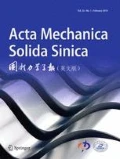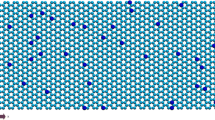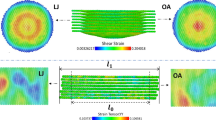Abstract
Molecular dynamics (MD) simulations were performed to stretch the rectangular graphene sheets doped with silicon, nitrogen or boron atoms. Young’s modulus, ultimate stress (strain) and energy absorption were measured for the graphene sheets with the doping concentration (DC) ranging from 0 to 5%. The emphasis was placed on the distinct effects of each individual dopant on the fundamental mechanical properties of graphene. The results indicated that incorporating the dopants into graphene led to an almost linear decrease in Young’s modulus. Monotonic reductions in ultimate strength, ultimate strain and energy absorption were also observed. Such doping effects were found to be most significant for silicon, less pronounced for boron, and small or negligible for nitrogen. The outputs provide an important guidance for the development and optimization of novel nanoscale devices, and facilitate the development of graphene-based M/NEMS.
Similar content being viewed by others
References
Novoselov, K.S., Geim, A.K., Morozov, S.V., Jiang, D., Zhang, Y., Dubonos, S.V., et al., Electric field effect in atomically thin carbon films. Science, 2004, 306(5696): 666–669.
van den Brink, J., Graphene: from strength to strength. Nature Nanotechnology, 2007, 2(4): 199–201.
Geim, A.K. and Novoselov, K.S., The rise of graphene. Nature Materials, 2007, 6(3): 183–191.
Lee, C., Wei, X., Kysar, J.W. and Hone, J., Measurement of the elastic properties and intrinsic strength of monolayer graphene. Science, 2008, 321(5887): 385–388.
Balandin, A.A., Ghosh, S., Bao, W., Calizo, I., Teweldebrhan, D., Miao, F., et al., Superior thermal conductivity of single-layer graphene. Nano Letters, 2008, 8(3): 902–907.
Areshkin, D.A. and White, C.T., Building blocks for integrated graphene circuits. Nano Letters, 2007, 7(11): 3253–3259.
Brownson, D.A.C. and Banks, C.E., Limitations of CVD graphene when utilised towards the sensing of heavy metals. Rsc Advances, 2012, 2(12): 5385–5389.
Schwierz, F., Graphene transistors. Nature Nanotechnology, 2010, 5(7): 487–496.
Novoselov, K.S., Fal’ko, V.I., Colombo, L., Gellert, P.R., Schwab, M.G. and Kim, K., A roadmap for graphene. Nature, 2012, 490(7419): 192–200.
Hashimoto, A., Suenaga, K., Gloter, A., Urita, K. and Iijima, S., Direct evidence for atomic defects in graphene layers. Nature, 2004, 430(7002): 870–873.
Meyer, J.C., Kisielowski, C., Erni, R., Rossell, M.D., Crommie, M.F. and Zettl, A., Direct imaging of lattice atoms and topological defects in graphene membranes. Nano Letters, 2008, 8(11): 3582–3586.
Carr, L.D. and Lusk, M.T., Defect engineering: Graphene gets designer defects. Nature Nanotechnology, 2010, 5(5): 316–317.
He, L.C., Guo, S.S., Lei, J.C., Sha, Z.D. and Liu, Z.S., The effect of Stone-Thrower-Wales defects on mechanical properties of graphene sheets—a molecular dynamics study. Carbon, 2014, 75: 124–132.
Sha, Z.D., Pei, Q.X., Liu, Z.S., Shenoy, V.B. and Zhang, Y.W., Is the failure of large-area polycrystalline graphene notch sensitive or insensitive? Carbon, 2014, 72: 200–206.
Sha, Z.D., Quek, S.S., Pei, Q.X., Liu, Z.S., Wang, T.J., Shenoy, V.B., et al., Inverse pseudo hall-petch relation in polycrystalline graphene. Scientific Reports, 2014, 4: 5991.
Riedl, C., Coletti, C. and Starke, U., Structural and electronic properties of epitaxial graphene on SiC(0001): a review of growth, characterization, transfer doping and hydrogen intercalation. Journal of Physics D—Applied Physics, 2010, 43(37): 374009.
Guo, B.D., Liu, Q.A., Chen, E.D., Zhu, H.W., Fang, L.A. and Gong, J.R., Controllable N-doping of graphene. Nano Letters, 2010, 10(12): 4975–4980.
Chi, M. and Zhao, Y.P., Adsorption of formaldehyde molecule on the intrinsic and Al-doped graphene: a first principle study. Computational Materials Science, 2009, 46(4): 1085–1090.
Wang, X.R., Li, X.L., Zhang, L., Yoon, Y., Weber, P.K., Wang, H.L., et al., N-Doping of graphene through electrothermal reactions with ammonia. Science, 2009, 324(5928): 768–771.
Lv, R.T. and Terrones, M., Towards new graphene materials: doped graphene sheets and nanoribbons. Materials Letters, 2012, 78: 209–218.
Lv, R., Li, Q., Botello-Mendez, A.R., Hayashi, T., Wang, B., Berkdemir, A., et al., Nitrogen-doped graphene: beyond single substitution and enhanced molecular sensing. Scientific Reports, 2012, 2: 586.
Wang, Y., Shao, Y.Y., Matson, D.W., Li, J.H. and Lin, Y.H., Nitrogen-doped graphene and its application in electrochemical biosensing. Acs Nano, 2010, 4(4): 1790–1798.
Mortazavi, B., Ahzi, S., Toniazzo, V. and Remond, Y., Nitrogen doping and vacancy effects on the mechanical properties of graphene: a molecular dynamics study. Physics Letters A, 2012, 376(12–13): 1146–1153.
Mortazavi, B. and Ahzi, S., Molecular dynamics study on the thermal conductivity and mechanical properties of boron doped graphene. Solid State Communications, 2012, 152(15): 1503–1507.
Zheng, Q.B., Li, Z.G. and Yang, J.H., Effects of N doping and NH2 grafting on the mechanical and wrinkling properties of graphene sheets. Rsc Advances, 2013, 3(3): 923–929.
Plimpton, S., Fast parallel algorithms for short-range molecular-dynamics. Journal of Computational Physics, 1995, 117(1): 1–19.
Tersoff, J., Modeling solid-state chemistry: interatomic potentials for multicomponent systems. Physical Review B: Condensed Matter and Materials Physics, 1989, 39(8): 5566–5568.
Tersoff, J., Erratum: modeling solid-state chemistry: Interatomic potentials for multicomponent systems. Physical Review B: Condensed Matter and Materials Physics, 1990, 41(5): 3248.
Bu, H., Chen, Y.F., Zou, M., Yi, H., Bi, K.D. and Ni, Z.H., Atomistic simulations of mechanical properties of graphene nanoribbons. Physics Letters A, 2009, 373(37): 3359–3362.
Mortazavi, B., Remond, Y., Ahzi, S. and Toniazzo, V., Thickness and chirality effects on tensile behavior of few-layer graphene by molecular dynamics simulations. Computational Materials Science, 2012, 53(1): 298–302.
Gupta, S., Dharamvir, K. and Jindal, V.K., Elastic moduli of single-walled carbon nanotubes and their ropes. Physical Review B: Condensed Matter and Materials Physics, 2005, 72(16): 165428.
Lindsay, L. and Broido, D.A., Optimized Tersoff and Brenner empirical potential parameters for lattice dynamics and phonon thermal transport in carbon nanotubes and graphene. Physical Review B: Condensed Matter and Materials Physics, 2010, 81: 205441.
Kinaci, A., Haskins, J.B., Sevik, C. and Cagin, T., Thermal conductivity of BN-C nanostructures. Physical Review B: Condensed Matter and Materials Physics, 2012, 86(11): 115410.
Matsunaga, K., Fisher, C. and Matsubara, H., Tersoff potential parameters for simulating cubic boron carbonitrides. Japanese Journal of Applied Physics Part 2—Letters, 2000, 39(1ab): L48–L51.
Moon, W.H., Son, M.S. and Hwang, H.J., Molecular-dynamics simulation of structural properties of cubic boron nitride. Physica B—Condensed Matter, 2003, 336(3–4): 329–334.
Stuart, S.J., Tutein, A.B. and Harrison, J.A., A reactive potential for hydrocarbons with intermolecular interactions. Journal of Chemical Physics, 2000, 112(14): 6472–6486.
Han, T.W., He, P.F., Wang, J., Zheng, B.L. and Wu, A.H., Strain rate dependences of tensile failure process for single graphene sheet: a molecular dynamics study. Science in China Series G: Physics, Mechanics, Astronomy, 2009, 39(9): 1312–1319.
Han, T.W., Luo, Y. and Wang, C.Y., Effects of temperature and strain rate on the mechanical properties of hexagonal boron nitride nanosheets. Journal of Physics D—Applied Physics, 2014, 47(2): 025303.
Chen, M.Q., Quek, S.S., Sha, Z.D., Chiu, C.H., Pei, Q.X. and Zhang, Y.W., Effects of grain size, temperature and strain rate on the mechanical properties of polycrystalline graphene—a molecular dynamics study. Carbon, 2015, 85: 135–146.
Dumitrica, T., Hua, M. and Yakobson, B.I., Symmetry-, time-, and temperature-dependent strength of carbon nanotubes. Proceedings of the National Academy of Sciences of the United States of America, 2006, 103(16): 6105–6109.
Dumitrica, T. and Yakobson, B.I., Strain-rate and temperature dependent plastic yield in carbon nanotubes from ab initio calculations. Applied Physics Letters, 2004, 84(15): 2775–2777.
Zhao, H. and Aluru, N.R., Temperature and strain-rate dependent fracture strength of graphene. Journal of Applied Physics, 2010, 108(6): 064321.
Swope, W.C., Anderson, H.C., Berens, P.H. and Wilson, K.R., A computer simulation method for the calculation of equilibrium constants for the formation of physical clusters of molecules: application to small water clusters. The Journal of Chemical Physics, 1982, 76(1): 637–649.
Nose, S., A molecular dynamics method for simulation in the canonical ensemble. Molecular Physics, 1984, 52(2): 255–268.
Hoover, W.G., Canonical dynamics: Equilibrium phase-space distributions. Physical Review A, 1985, 31(3): 1695–1697.
Lee, C., Wei, X.D., Kysar, J.W. and Hone, J., Measurement of the elastic properties and intrinsic strength of monolayer graphene. Science, 2008, 321(5887): 385–388.
Gupta, A., Chen, G., Joshi, P., Tadigadapa, S. and Eklund, P.C., Raman scattering from high-frequency phonons in supported n-graphene layer films. Nano Letters, 2006, 6(12): 2667–2673.
Salvetat, J.P., Bonard, J.M., Thomson, N.H., Kulik, A.J., Forro, L., Benoit, W., et al., Mechanical properties of carbon nanotubes. Applied Physics A—Materials Science & Processing, 1999, 69(3): 255–260.
Wang, C.Y. and Zhang, L.C., A critical assessment of the elastic properties and effective wall thickness of single-walled carbon nanotubes. Nanotechnology, 2008, 19(7): 075705.
Liu, F., Ming, P.M. and Li, J., Ab initio calculation of ideal strength and phonon instability of graphene under tension. Physical Review B: Condensed Matter and Materials Physics, 2007, 76(6): 064120.
Zang, J.L., Yuan, Q.Z., Wang, F.C. and Zhao, Y.P., A comparative study of Young’s modulus of single-walled carbon nanotube by CPMD, MD and first principle simulations. Computational Materials Science, 2009, 46(3): 621–625.
Pei, Q.X., Zhang, Y.W. and Shenoy, V.B., A molecular dynamics study of the mechanical properties of hydrogen functionalized graphene. Carbon, 2010, 48(3): 898–904.
Ni, Z.H., Bu, H., Zou, M., Yi, H., Bi, K.D. and Chen, Y.F., Anisotropic mechanical properties of graphene sheets from molecular dynamics. Physica B—Condensed Matter, 2010, 405(5): 1301–1306.
Han, T.W., He, P.F., Wang, J. and Zheng, B.L., Molecular dynamics simulation of single graphene sheet under tension. New Carbon Materials, 2010, 25(4): 261–266.
Author information
Authors and Affiliations
Corresponding author
Additional information
Project supported by the Natural Science Foundation of Jiangsu Province (Nos. BK2011490 and BK20151336), Program of Talents in Innovation and Entrepreneurship of Jiangsu Province and the National Natural Science Foundation of China (No. 21204031).
Rights and permissions
About this article
Cite this article
Han, T., Luo, Y. & Wang, C. Effects of SI, N and B Doping on the Mechanical Properties of Graphene Sheets. Acta Mech. Solida Sin. 28, 618–625 (2015). https://doi.org/10.1016/S0894-9166(16)30003-9
Received:
Revised:
Published:
Issue Date:
DOI: https://doi.org/10.1016/S0894-9166(16)30003-9




